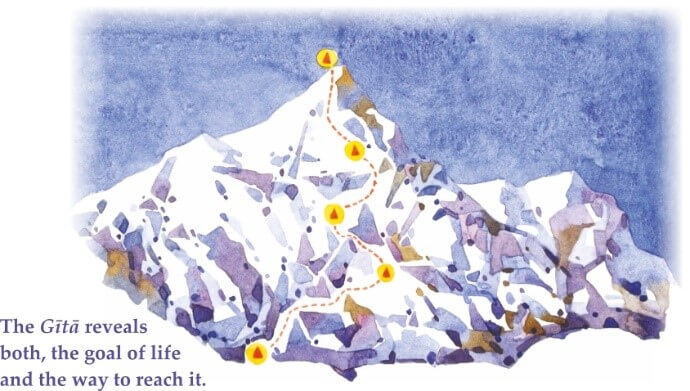
Death, ignorance and sorrow are the three fundamental issues of human beings which are addressed by the Bhagavad Gita. Against these, through all our pursuits we are trying to achieve immortality, awareness and everlasting and infinite happiness.

All the fields of knowledge, acknowledge these fundamental issues of death, ignorance and sorrow as real and try to offer solutions. These solutions, however, yield only limited and temporary relief. On the other hand, the Bhagavad Gita reveals the True nature of a human being; That which is beyond death, ignorance and sorrow which is SatChitAnanda Swaroopa. It also reveals the True nature of this World and the God and how the Truth of a being is the same as the Truth of these. Realizing one’s True nature, all the limitations, bondages and sufferings of a mortal, limited being are negated. It is only this realization which will truly satisfy us and this is the only way by which the human quest can get really fulfilled and forever. While the Bhagavad Gita reveals this vision of the Ultimate Truth, it also acknowledges the difficulty in realizing it and relating it our day-to-day life with this vision. It shows the path of realising this supreme goal, using our day-to-day worldly life itself. Thus, the Bhagavad Gita reveals the knowledge of the ultimate goal of human life and the way to lead a purposeful, fulfilling life. Being the fundamental knowledge about our life, it will naturally be of great help if we know and clearly understand it at the earliest. This knowledge of the Ultimate Truth is known as Brahmavidya and the methodology to realize it thorough our day-to-day life is called the Yogashastra.

Vedanta is the field of knowledge which deals with enquiry into the Ultimate Truth. The Truth is that, where all that is perceivable finally resolves. This is spiritual knowledge. This knowledge is Brahmavidya. There are three main texts, dealing with this area of knowledge – the Bhagavad Gita itself, the Upanishads and the Brahmasutra
The three texts, the Bhagavad Gita, the Upanishads and the Brahmasutra are together referred to as the ‘Prasthanatraya. ‘Prasthana means to proceed and ‘Traya means three. Prasthanatraya means the three texts, which help us to proceed to our goal - Moksha (liberation). ‘Prasthana’ also means the highest place. These texts have the highest place among all the texts. Shri Adya Shankaracharya has written commentaries on the Bhagavad Gita, ten of the Upanishads and the Brahmasutra. These commentaries are referred to by masters as the authentic explanations of these texts.
Each Upanishad is a dialogue between the Sadguru (the teacher of the spiritual knowledge) and the disciple. In the course of the discussion, it unfolds the Ultimate Truth. There are several of these Upanishads. Various Upanishads appear at the end of each Veda. Vedas are ancient texts. There are four Vedas – the Rigveda, the Yajurveda, the Samaveda, and the Atharvanaveda (also known as Atharvaveda). The bulk of each Veda deals with worldly life and well-being. This is called ‘Bhukti’. This is the first part of each Veda and is called Karmakanda. Generally, this part is implied when reference is made to the Vedas. The last part of each Veda consists of the Upanishads, which transcend worldly life and deal with spiritual knowledge or the knowledge of the Ultimate Truth. This leads to ultimate liberation or bliss, the ‘Mukti’. This section of each Veda is called Jnanakanda or Vedanta.
This is a text written by the great sage Sri Vyasa (also known as Badarayana). It discusses all the aspects of the Spiritual Truth through various methods of logical analysis and organizes the knowledge of the Upanishads.
There are additional texts called Prakaranagrantha. In order to understand the Prasthanatraya better, great Acharyas or masters such as Shri Adya Shankaracharya have written certain additional texts like Tattva Bodha, Atma Bodha, Druk Drushya Viveka, Vivek Chudamani etc., which are called Prakaranagrantha. These are introductory texts that help the seeker to understand Vedanta and prepare him for the study of the Prasthanatraya.

The Prasthanatraya are generally studied in a sequence, starting with the Bhagavad Gita, then at least the ten Upanishads on which Shri Adya Shankaracharya has written commentaries, followed by the Brahmasutra. Some Prakaranagrantha are studied in the beginning while some are studied in between. Upanishads are the most ancient; then came the Brahmasutra, followed by the Bhagavad Gita, which communicates all this knowledge. The subject matter of each of these texts is the same - Spiritual Truth or the Ultimate Reality.
The Bhagavad Gita summarizes all the knowledge of the various Vedanta texts. Bhagavad Gita is the essence of all Vedanta.
Generally, the Vedanta texts focus on and elaborate mainly the Brahmavidya. It is also the main topic of the Bhagavad Gita. However, in addition, an in-depth discussion of Yogashastra is the special contribution of the Bhagavad Gita. Arjuna appreciated the vision of the Ultimate Truth, but being a worldly person like most of us, he had a problem. He did not know how to achieve his goal and also had difficulty in reconciling the life he was living with this vision. That is why Lord Krishna elaborated the Yogashastra and showed him the way of living his day-to-day life and achieving the supreme goal.